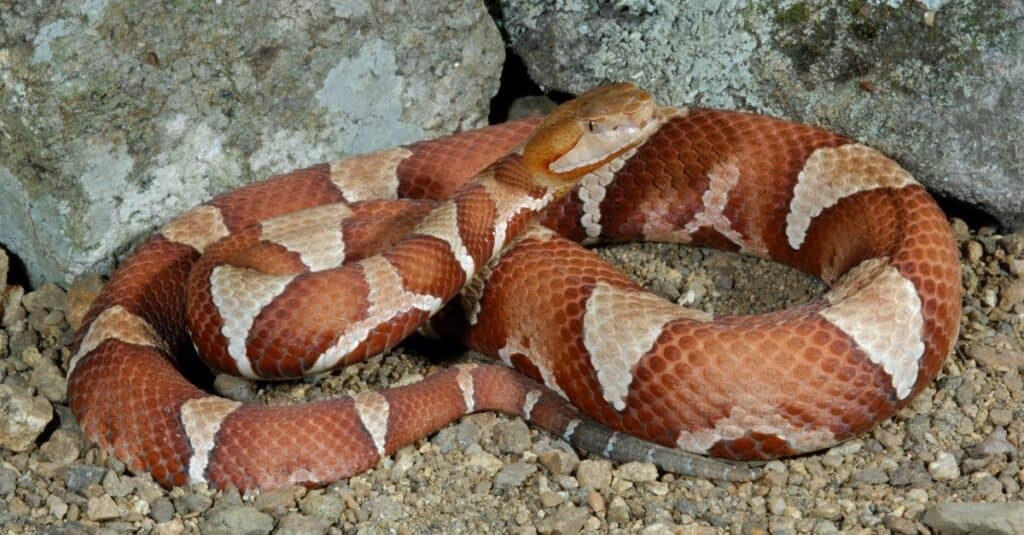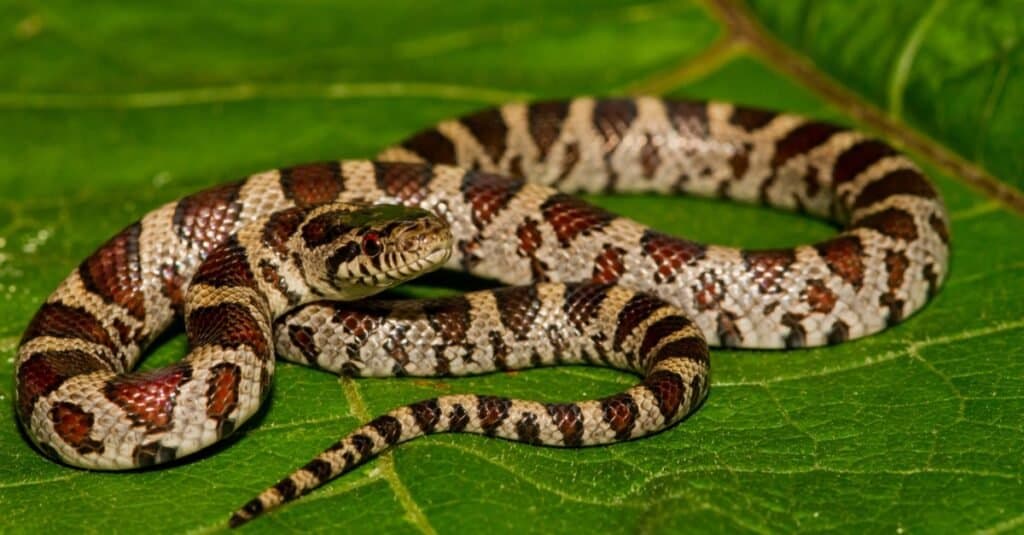Comparing milk snakes vs copperheads is a common occurrence, given that these two snakes share the same range in many parts of North America. However, with some simple tricks, you can learn how to identify these reptiles with ease, especially given how many differences they have. For example, milk snakes are from the Colubridae family, while copperheads are from the Viperidae family. But this is only where their differences begin.
Milk snakes and copperheads are easy to tell apart once you learn about some of their distinguishing features. Given that milk snakes are non-venomous and copperheads are venomous, it is useful to know the differences between these two. However, any snake found in the wild is best left alone if you happen to find one!
In this article, we will address the differences between milk snakes and copperhead snakes so that you can learn how to identify them and know key facts about them. Let’s get started.
Comparing Milk Snakes vs Copperheads

| Milk Snake | Copperhead | |
|---|---|---|
| Venomous? | No | Yes |
| Size | 2-5 feet; skinny and uniform | 2-4 feet; thicker body overall |
| Color | Orange, black, yellow, white | Shades of brown, tan, and white |
| Habitat | United States woodlands | North American woodlands and leaf piles |
| Markings | Distinct stripes in different colors | Distinct diamond or hourglass pattern |
| Eggs | Yes | No (live birth only) |
The 5 Key Differences Between Milk Snake vs Copperhead

Milk snakes are striped or banded, with alternating colors; copperheads are uniquely patterned with hourglasses or other distinct patterns, and they are always in shades of brown or gray.
©Seregraff/Shutterstock.com
There are key differences that separate milk snakes vs copperheads. Milk snakes are non-venomous snakes, while copperheads are known for their dangerous venom. Copperheads are also a very different color and pattern from milk snakes. Copperheads are often brown and patterned with hourglasses, while milk snakeskin includes many bright colors and has stripes.
There are a few other differences between milk snakes vs copperheads. Let’s learn more about them now.
Milk Snake vs Copperhead: Markings and Coloring
One of the main differences between milk snakes vs copperheads is their markings and color. Milk snakes are striped or banded, with alternating colors; copperheads are uniquely patterned with hourglasses or other distinct patterns, and they are always in shades of brown or gray. You can easily tell the difference between copperheads and milk snakes based on their markings alone.

Milk snakes use constriction to kill their prey, while copperheads use their weak venom to slowly kill their meals.
©Breck P. Kent/Shutterstock.com
Milk Snake vs Copperhead: Hunting
Another difference between milk snakes and copperheads is their hunting techniques. Milk snakes use constriction to kill their prey, while copperheads use their weak venom to incapacitate their meals. Milk snakes and copperheads eat a similar diet, though copperheads can eat larger prey than milk snakes can.
Copperheads prefer to eat larger rodents, birds, and insects, while milk snakes eat smaller rodents, eggs, and even other snakes. Another unique hunting method that copperheads don’t share with milk snakes is that they inject their prey with venom and leave them be until they die. This keeps a copperhead safe, given that their venom isn’t powerful enough to kill anything immediately.
Milk Snake vs Copperhead: Venom
Speaking of venom, this is another thing that differs between milk snakes and copperheads. Milk snakes are a non-venomous snake variety, while copperheads have a fairly mild venom inside of them. It can still be dangerous to leave a copperhead bite untreated, and milk snakes can also bite you.
However, no matter the amount of venom present in a copperhead, they can still be dangerous. They are a commonly found species of snake, often sunning and spending time with other snake species. While they shouldn’t attack unless provoked, both milk snakes and copperheads can still bite.

Copperheads prefer to eat larger rodents, birds, and insects, while milk snakes eat smaller rodents, eggs, and even other snakes.
©Jay Ondreicka/Shutterstock.com
Milk Snake vs Copperhead: Pupils and Head Shape
A key distinguishing feature for milk snakes vs copperheads has to be their pupils and head shapes. Copperheads have vertical narrow slits for their pupils, and milk snakes have rounded pupils. This is an easy way to tell the difference between venomous and non-venomous snakes, though you may not want to get that close to a snake in order to find out!
Milk snakes have a rounded and uniform head-to-neck ratio, while a copperhead has a more bulbous and triangular-shaped viper head. This is another common theme with venomous snakes, though it isn’t a guarantee- there’s always an exception to every rule!

Copperheads have vertical narrow slits for their pupils, and milk snakes have rounded pupils.
©Jeff W. Jarrett/Shutterstock.com
Milk Snake vs Copperhead: Body Shape
Finally, the body shape matters when it comes to milk snakes vs copperheads. Milk snakes are slender and narrow snakes, with a uniformly shaped body from head to tail. Copperheads have a large viper head with a wider and thicker body. Given these opposite sizes, the overall body length and size between these two snakes is very different.
For example, copperheads do not grow as long as milk snakes — milk snakes are simply more slender and longer. This can be an easy way to help you identify these snakes should you stumble upon one in their natural habitat!
What Venomous Snake Looks Like a Milk Snake?

The venomous eastern coral snake has wide bands of black or red divided by thin yellow outlines.
©Mark_Kostich/Shutterstock.com
So now that you can tell copperheads apart from milk snakes, you thought you had it covered. But there’s another venomous snake that almost looks like the spitting image of a milksnake, but it carries a very toxic bite. The venomous coral snake is hard to tell apart from a milksnake because their banded markings are almost the same, as well as their thin, long bodies and the shape of their heads.
On appearances alone, the best way to tell them apart is by their coloring and patterns. Coral snakes are more colored, typically with black, red, and yellow bands. The black and red bands are wider with thin yellow outlines separating each. Milk snakes, on the other hand, are often red, black, and yellow or varying shades with darker colors outlined with wider sections of black.
Another key difference between these snakes is the method of killing prey. While milk snakes squeeze prey to death by constriction, coral snakes utilize their venom to kill prey. Coral snakes typically eat frogs, lizards, and other snakes.
The photo featured at the top of this post is © Siarhei Kasilau/Shutterstock.com
Discover the "Monster" Snake 5X Bigger than an Anaconda
Every day A-Z Animals sends out some of the most incredible facts in the world from our free newsletter. Want to discover the 10 most beautiful snakes in the world, a "snake island" where you're never more than 3 feet from danger, or a "monster" snake 5X larger than an anaconda? Then sign up right now and you'll start receiving our daily newsletter absolutely free.
FAQs (Frequently Asked Questions)
Are milk snakes harmful?
Milk snakes can be dangerous, but they do not have any venom. In fact, many milk snakes are bred for pet stores and homes to keep as pets. However, this doesn’t mean that a wild milk snake is friendly. Many milk snakes can also mimic venomous snakes to protect themselves, so it’s always best to give them space should you see them in the wild.
How poisonous is a copperhead?
Copperheads are poisonous, but they rarely bite with a lethal amount of venom. They are also fairly shy and prefer to avoid conflict whenever possible.
Thank you for reading! Have some feedback for us? Contact the AZ Animals editorial team.







